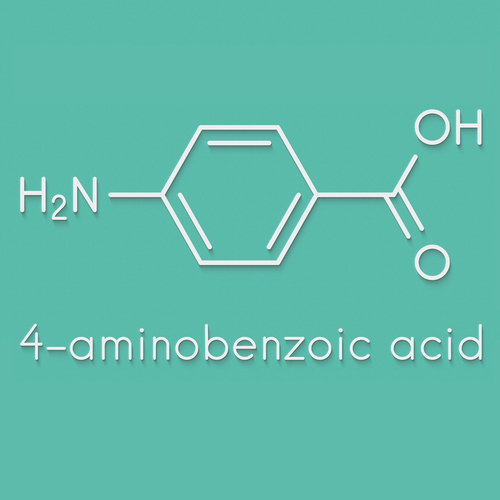
Para-aminobenzoic acid (paba)
Scientific names: Para-aminobenzoic acid
Alternative names: 4-Aminobenzoic Acid, ABA, Acide 4-aminobenzoïque, Acide Aminobenzoïque, Acide p-aminobenzoïque, Acide Para-Amino-Benzoïque, Acide Paraaminobenzoïque, Acide Para-Aminobenzoïque, Acido Para Aminobenzoico, Aminobenzoate Potassium, Aminobenzoic Acid, Bacterial Vitamin H1, Ethyl Dihydroxypropyl Aminobenzoate, Glyceryl Paraaminobenzoate, Octyl Diemthyl PABA, P-Aminobenzoic Acid, PABA, Padamate O, Para-Aminobenzoate, Vitamin B10, Vitamin Bx, Vitamin H1, Vitamine B10, Vitamine Bactérienne H1, Vitamine Bx
Actions: Antiarthritic effect, Dermatologic effect, Photoprotective effect, Tissue oxygenating effect
Background
Para-aminobenzoic acid (PABA) is a chemical that occurs naturally in the body. It is also found in several foods including grains, eggs, milk, and meat.
PABA is part of the folic acid molecule. It was once considered a B vitamin but is now considered a nonessential nutrient. PABA is used as a sunscreen because it can block ultraviolet (UV) radiation to the skin.
People use PABA for sunburn protection and for a disease that causes curved, painful erections (Peyronie disease). It is also used for hardening of skin and connective tissue (scleroderma), aging skin, infertility, and many other conditions, but there is no good scientific evidence to support these uses.
PABA is part of the folic acid molecule. It was once considered a B vitamin but is now considered a nonessential nutrient. PABA is used as a sunscreen because it can block ultraviolet (UV) radiation to the skin.
People use PABA for sunburn protection and for a disease that causes curved, painful erections (Peyronie disease). It is also used for hardening of skin and connective tissue (scleroderma), aging skin, infertility, and many other conditions, but there is no good scientific evidence to support these uses.
Safety Safety definitions
When taken by mouth: PABA is possibly safe when used appropriately. It's FDA-approved for use and generally well-tolerated. Side effects might include nausea, vomiting, upset stomach, anorexia, and rash. PABA is possibly unsafe when used in high doses. Taking more than 12 grams daily can cause serious side effects, including liver and kidney problems.
When applied to the skin: PABA is likely safe. It's FDA-approved for use and generally well-tolerated.
Children: PABA is likely safe when applied to the skin for children. PABA is possibly safe for children when taken by mouth in doses of 220 mg/kg daily or less. But PABA is possibly unsafe when taken by mouth in higher doses.
Kidney disease: PABA might build up in the kidneys and make kidney disease worse.
When applied to the skin: PABA is likely safe. It's FDA-approved for use and generally well-tolerated.
Special Precautions & Warnings:
Pregnancy and breast-feeding: PABA is likely safe when applied to the skin during pregnancy or breast-feeding. But there isn't enough reliable information to know if PABA is safe to take by mouth when pregnant or breast-feeding. Stay on the safe side and avoid use.Children: PABA is likely safe when applied to the skin for children. PABA is possibly safe for children when taken by mouth in doses of 220 mg/kg daily or less. But PABA is possibly unsafe when taken by mouth in higher doses.
Kidney disease: PABA might build up in the kidneys and make kidney disease worse.
Effectiveness
NatMed Pro rates effectiveness based on scientific evidence according to the following scale: Effective, Likely Effective, Possibly Effective, Possibly Ineffective, Likely Ineffective, Ineffective, and Insufficient Evidence to Rate.
Effective Effectiveness definitions
- Sunburn. Applying PABA to the skin prevents sunburn. PABA is an FDA-approved sunscreen.
Possibly effective Effectiveness definitions
- A disease that causes curved, painful erections (Peyronie disease). Taking PABA by mouth improves symptoms of Peyronie disease. PABA is FDA-approved for use in this condition.
Possibly ineffective Effectiveness definitions
- Hardening of skin and connective tissue (scleroderma). Taking PABA by mouth doesn't seem to improve scleroderma. Although PABA is FDA-approved for scleroderma, there is only limited evidence that it is effective.
Dosing & administration
PABA has most often been used by adults in doses of 12 grams by mouth daily in 4 to 6 divided doses. It has also been used by children in doses depending on weight. Potassium salt formulations of PABA are most common. PABA is also used in sunscreens applied to the skin.
Interactions with pharmaceuticals
Antibiotics (Sulfonamide antibiotics)
Interaction Rating=Major Do not take this combination.
PABA can decrease the effectiveness of certain antibiotics called sulfonamides.
Dapsone (Avlosulfon)
Interaction Rating=Major Do not take this combination.
Dapsone is used as an antibiotic. PABA might decrease the effectiveness of dapsone for treating infections.
Interactions with herbs & supplements
There are no known interactions with herbs and supplements.
Interactions with foods
There are no known interactions with foods.
vital.ly has licensed monographs from TRC Healthcare.
This monograph was last reviewed on 14/02/2025 11:00:00 and last updated on 20/04/2018 17:14:45. Monographs are reviewed and/or updated multiple times per month and at least once per year.
Natural Medicines disclaims any responsibility related to medical consequences of using any medical product. Effort is made to ensure that the information contained in this monograph is accurate at the time it was published. Consumers and medical professionals who consult this monograph are cautioned that any medical or product related decision is the sole responsibility of the consumer and/or the health care professional. A legal License Agreement sets limitations on downloading, storing, or printing content from this Database. No reproduction of this monograph or any content from this Database is permitted without written permission from the publisher. It is unlawful to download, store, or distribute content from this site.


